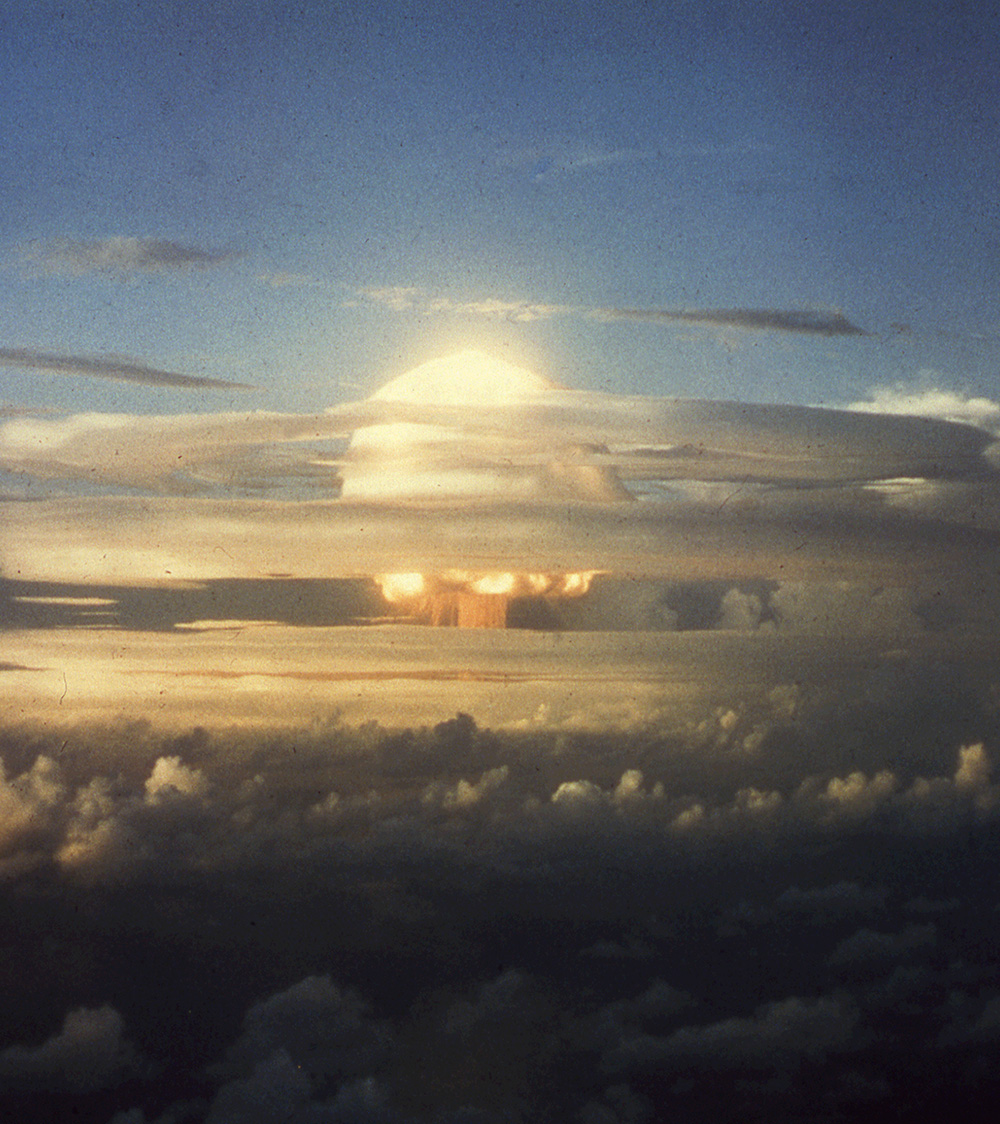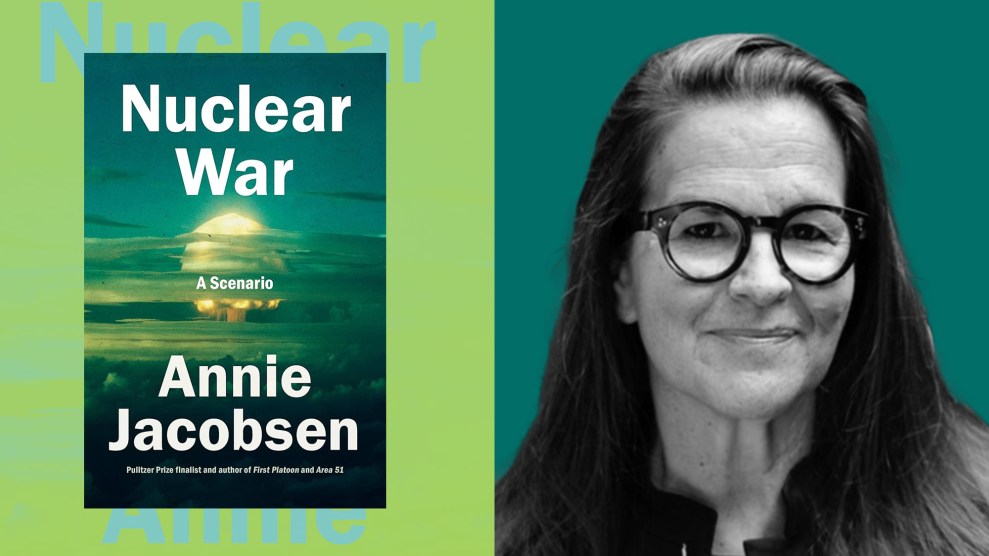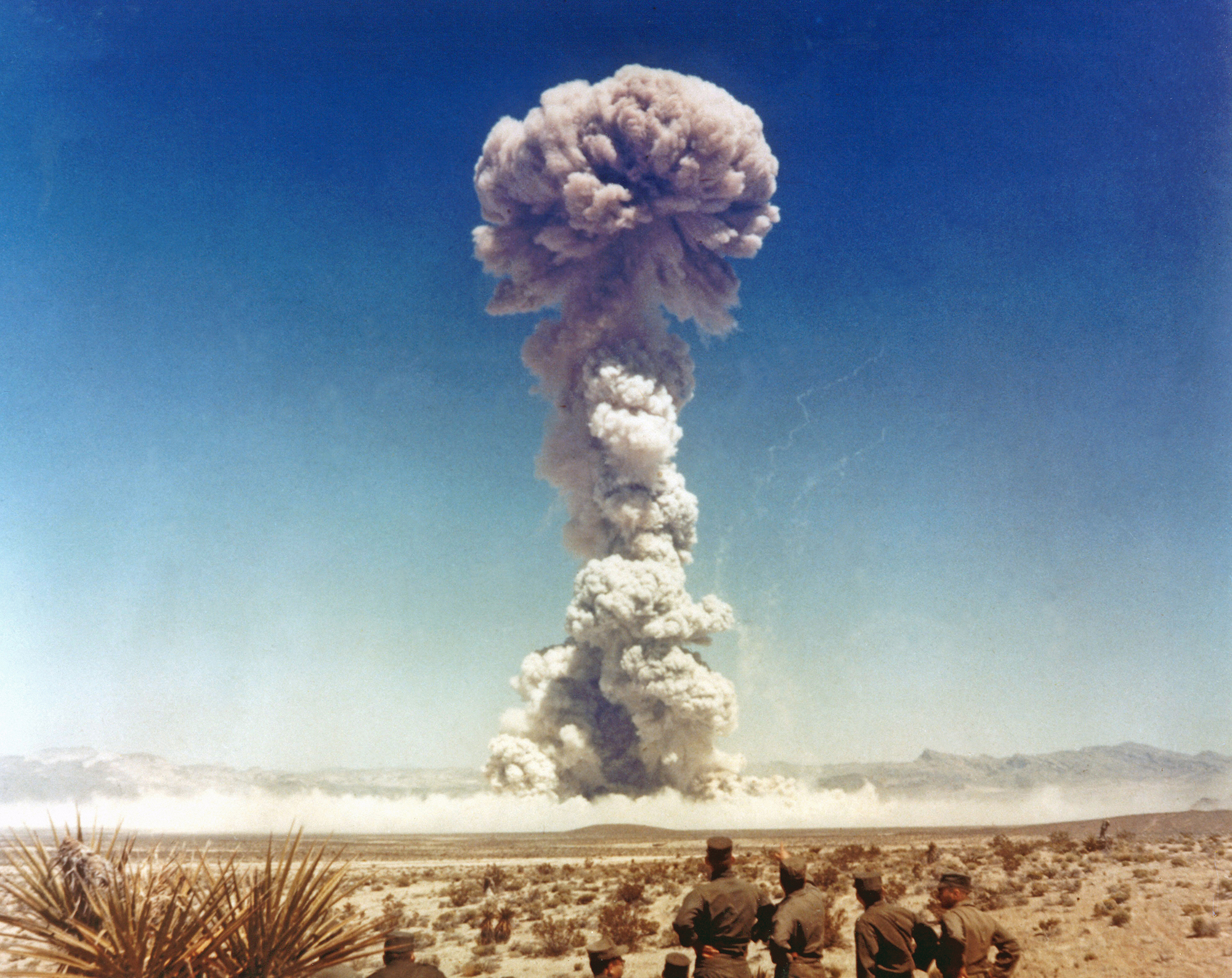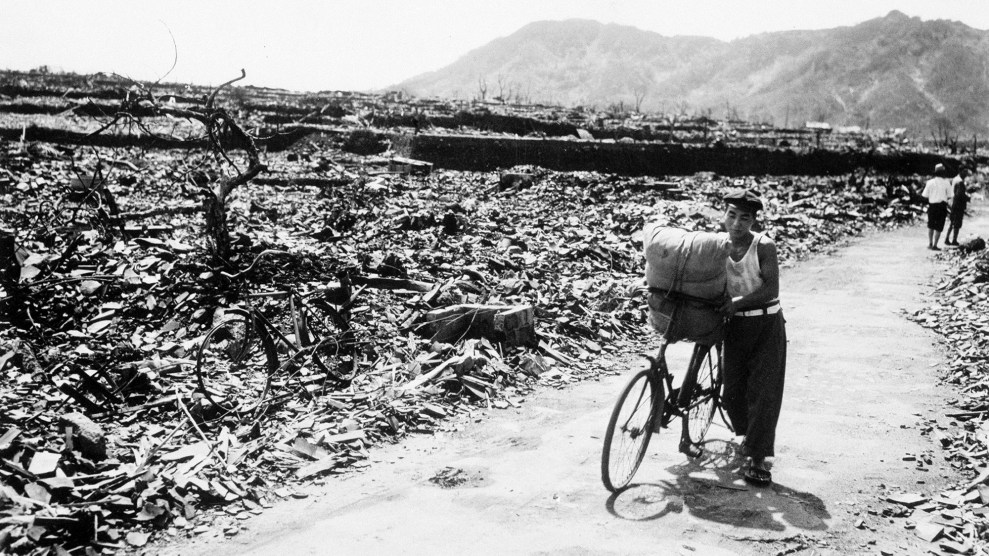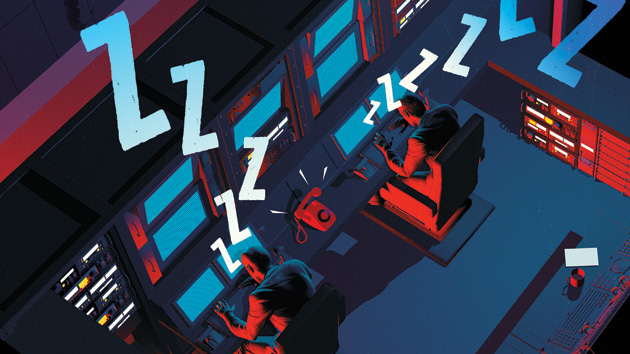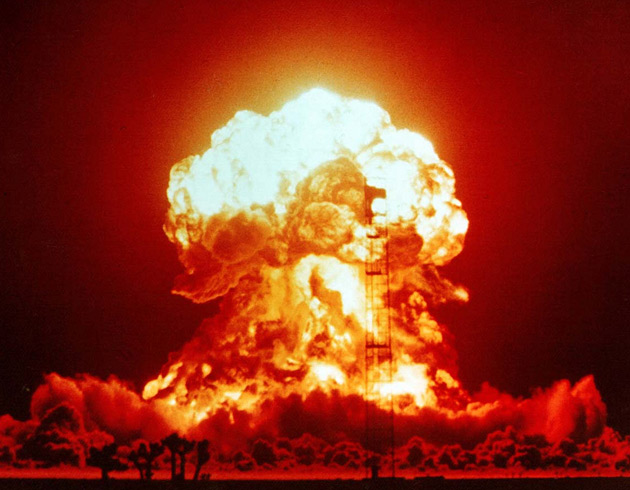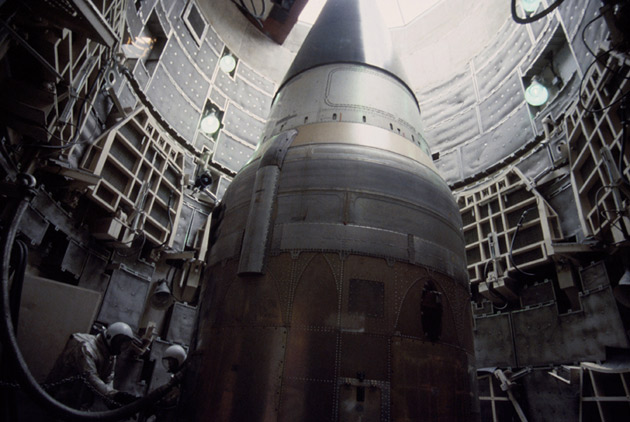This article was adapted from Nuclear War: A Scenario, published March 26, 2024, by Dutton, an imprint of Penguin Publishing Group, a division of Penguin Random House, LLC. Copyright 2024 by Annie M. Jacobsen.
Nuclear war is madness. Were a nuclear weapon to be launched at the United States, including from a rogue nuclear-armed nation like North Korea, American policy dictates a nuclear counterattack. This response would almost certainly set off a series of events that would quickly spiral out of control. “The world could end in the next couple of hours,” Gen. Robert Kehler, the former commander of US Strategic Command, told me in an interview.
We sit on the razor’s edge. Vladimir Putin has said he is “not bluffing” about the possibility of using weapons of mass destruction should NATO overstep on Ukraine, and North Korea accuses the US of having “a sinister intention to provoke a nuclear war.” For generations, the American public has viewed a nuclear World War III as a remote prospect, but the threat is ever-present. “Humanity is one misunderstanding, one miscalculation away from nuclear annihilation,” cautions UN Secretary-General António Guterres. “We must reverse course.”
So far, we haven’t. The Pentagon’s plans for nuclear war remain firmly in place.
The US government has spent trillions of dollars over the decades preparing to fight a nuclear war, while refining protocols meant to keep the government functioning after hundreds of millions of Americans become casualties of a nuclear holocaust, and the annual budgets continue to grow. The nation’s integrated nuclear war plan in the 1960s was utter madness. It almost certainly remains so today.
The plan being secretly shown at Strategic Air Command headquarters in 1960 had been a year or so in the making, ordered for the president by the secretary of defense. Fifteen years had passed since the two atomic weapons were dropped on Japan, each one killing tens of thousands of people in an instant, with thousands more burning to death in the ensuing firestorms.
Back in August 1945, the US had a third bomb ready to be shipped out, and enough nuclear material in its arsenal to produce a fourth bomb by the end of the month—the plan of action had Japan not surrendered. “The original atomic bombs were like school science projects,” says Dr. Glen McDuff, a long-serving Los Alamos nuclear weapons engineer and the former historian-curator of the laboratory’s classified museum. “Nineteen out of every 20 pieces of scientific equipment they had,” he explains, “they designed and built themselves with only about 80 common vacuum tubes.”
With World War II finally over, the fate of the Los Alamos National Laboratory was anyone’s guess. “After the war, with just one atomic bomb in the stockpile, the Los Alamos lab and town infrastructure crumbled,” reflects McDuff. “It was a daily struggle just to keep the lights on. Half the Los Alamos staff left. Things looked bleak. Until, that is, the Navy got involved.”
The US Navy was by far the most powerful maritime fighting force in the world. Deeply worried about its looming obsolescence in this new age of atomic warfare, it planned a live-action series of three atomic bomb tests for all to see.
Operation Crossroads was a grand, celebratory affair. A massive, public relations–based military test designed to demonstrate how 88 naval vessels could survive—even thrive—in a future nuclear battle at sea. More than 42,000 people gathered at Bikini Atoll in the Marshall Islands. World leaders, journalists, dignitaries, heads of state—they traveled to this far corner of the Pacific to witness the live-fire atomic explosions. This was America’s first use of an atomic weapon since the war. A demonstration of what lay ahead.
“For a crumbling Los Alamos in 1946,” says McDuff, “the Navy was their savior.”
Operation Crossroads injected the atomic bomb program with new life. By mid-1946, the American nuclear stockpile grew to nine bombs. After the test, the Joint Chiefs of Staff requested an evaluation of the “atomic bomb as a military weapon” to determine its next move. The report—classified until 1975—set the burgeoning military-industrial complex alight. The details were alarming.
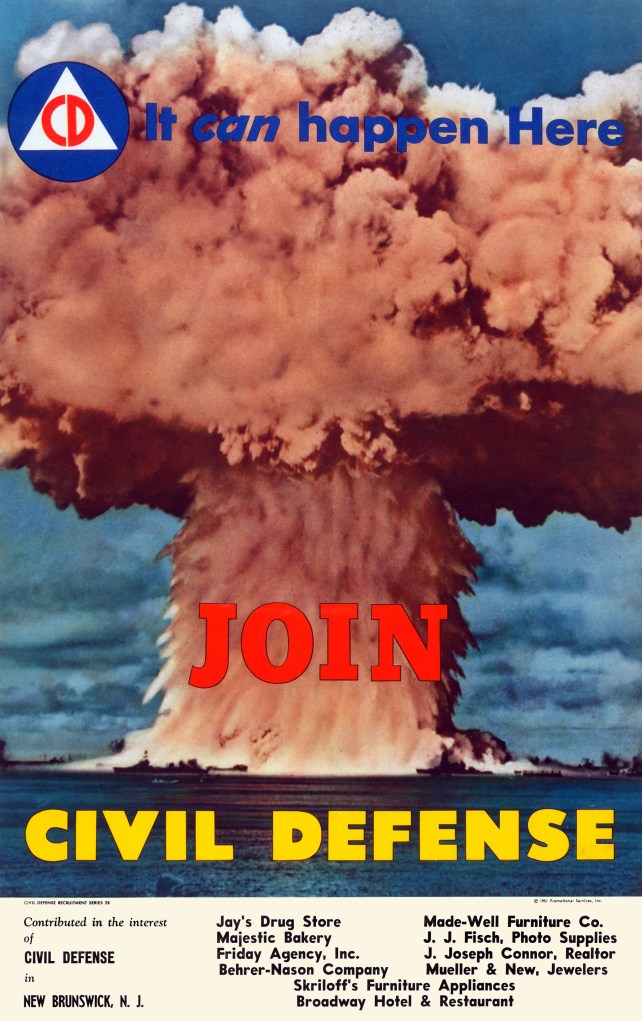
This Civil Defense recruitment poster featured a photo from a US nuclear weapon test at Bikini Atoll, July 1946.
Pierce Archive LLC/Buyenlarge/Getty
Atomic bombs were “a threat to mankind and to civilization,” warned the group of admirals, generals, and scientists who authored the report—“weapons of mass destruction” able to “depopulate vast areas of the Earth’s surface.” But they could also be very useful, the group told the Joint Chiefs. “If used in numbers,” they wrote, “atomic bombs not only can nullify any nation’s military effort, but can demolish its social and economic structures and prevent their reestablishment for long periods of time.”
The board’s recommendation was to stockpile more bombs. Russia would soon have its own atomic arsenal, the report made clear, and that made America vulnerable to a surprise attack—later dubbed a “bolt out of the blue” attack.
“With the advent of the Atomic bomb,” the board warned, “surprise has achieved supreme value so that an aggressor, striking suddenly and unexpectedly with a number of atomic bombs, [could] ensure the ultimate defeat of an initially stronger adversary”—meaning the United States.
What America had created presaged its own potential demise. “The United States has no alternative but to continue the manufacture and stockpiling of weapons,” the Joint Chiefs were advised. They took notice and approved.
By 1947, the US stockpile rose to 13 atomic bombs.
By 1948, there were 50.
By 1949, 170.
From declassified records, we now know that military planners agreed among themselves that 200 nuclear bombs provided enough firepower to destroy the entire Soviet empire. But that summer, the US monopoly on nuclear weapons came to its inevitable end. On August 29, 1949, the Russians exploded their first atomic bomb, an almost exact copy of the one the US had dropped on Nagasaki four years earlier. The bomb’s blueprints had been stolen from Los Alamos by a German-born, British-educated Communist spy, the Manhattan Project scientist Klaus Fuchs.
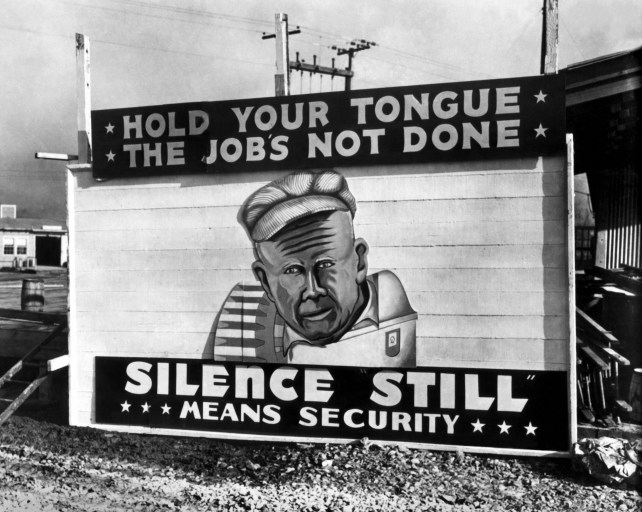
A 1943 security display at the Hawley Road Plant near Milwaukee, which secretly helped produce weapons-grade nuclear isotopes.
Galerie Bilderwelt/Getty
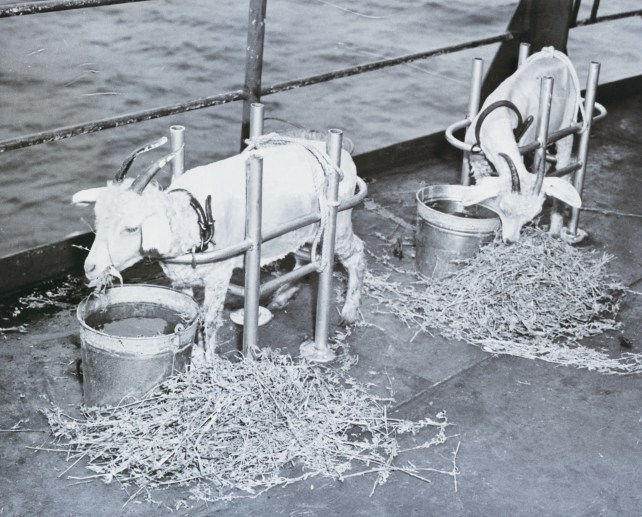
These goats, on a US target ship at Bikini Atoll in July 1946, were used as guinea pigs to study the effects of atomic blasts.
Bettmann/Getty
The race to build even more atomic bombs now accelerated dramatically. By 1950, the US had added 129 atomic weapons to its stockpile, bringing the total to 299. At the time, the Soviet Union had five.
The following year, in 1951, the number climbed to an astonishing 438 atomic weapons in America’s arsenal—more than twice the number the Joint Chiefs of Staff had been told could “depopulate vast areas of the Earth’s surface leaving only vestigial remnants of man’s material works.”
The next year, there was a near-doubling of the near-doubling.
By 1952, there were 841 atomic weapons in the US stockpile.
Eight hundred and forty-one.
With the US monopoly on nuclear weapons now over, the race for supremacy had taken on a new urgency. Halfway across the world, the Soviets began building atomic weapons at a frenzied pace. In just three years, the USSR grew its arsenal from one bomb to 50.
But the atomic bomb—its extraordinary power, its mass-killing capacity—would pale in comparison to what was coming next. American and Russian weapons designers each had radical new plans on their individual drawing boards. What followed was the invention, in 1952, of “the most destructive, inhumane, and indiscriminate weapon ever created,” in the words of a group of Nobel laureates. A climate-altering, famine-causing, civilization-ending, genome-changing, newer, bigger, and even more monstrous nuclear weapon—one that the scientists involved called “the Super.”
Indeed, the Super “works better in large sizes than in small sizes,” its designer, Richard Garwin, told me in an interview, confirming that, yes, “I am the architect of the Super…of this first thermonuclear bomb.” Edward Teller conceived it and Garwin drew it at a time when no one else knew how.
The Super was a two-stage mega-weapon: a nuclear bomb within a nuclear bomb. A thermonuclear weapon, also called a hydrogen bomb, uses an atomic (fission) bomb as its triggering mechanism—as an internal, explosive fuse. The Super’s explosive power is the result of an uncontrolled chain reaction in which the nuclei of hydrogen isotopes combine under extremely high temperatures, releasing tremendous energy.
An atomic bomb will kill tens of thousands of people immediately (and tens of thousands later, from follow-on effects), as did the bombs dropped on Hiroshima and Nagasaki. Whereas a thermonuclear bomb detonated on or over a city like New York or Seoul will kill millions of people in a superheated flash, followed by millions more from blast, firestorms, and radioactive fallout.
Garwin’s 1952 prototype had an explosive power of 10.4 megatons—the near equivalent of 1,000 Hiroshima bombs exploding all at once. It was an atrocious weapon. Garwin’s mentor, the Manhattan Project physicist Enrico Fermi, experienced a crisis of conscience at the very thought of such a horrifying weapon being built. Fermi and his colleague I.I. Rabi temporarily broke ranks with their weapons-building colleagues and wrote to President Truman, declaring the Super “an evil thing.”
As they put it: “The fact that no limits exist to the destructiveness of this weapon makes its very existence and the knowledge of its construction a danger to humanity as a whole. It is necessarily an evil thing considered in any light.”
But the president ignored the plea to stop building the Super, and Garwin was given the go-ahead to draw the plans. “If the hydrogen bomb was inherently evil, it’s still evil,” Garwin told me.
The Super was built. Its code name was Mike. The series was Ivy. “So it was the Ivy Mike test,” he said.
On November 1, 1952, it was test-fired on Elugelab island in the Marshall Islands. The Ivy Mike prototype weighed around 80 tons, an instrument of destruction so physically enormous it had to be constructed inside a corrugated-aluminum building 88 feet long and 46 feet wide.
Ivy Mike exploded with an unprecedented yield. The crater left behind was described in a classified report as being “large enough to hold 14 buildings the size of the Pentagon.” And while there is much to say about the inhumanely destructive power of thermonuclear weapons in general, two aircraft photographs—before and after shots of the Ivy Mike bomb test—tell the story.
In the top image below, Elugelab island appears as it had since its geological origin. In the bottom image, the island is gone. In its place is a crater two miles in diameter and 180 feet deep. Scorching the Earth with mass extermination weapons had just been one-upped by an order of magnitude. The invention of the Super brought with it the existence of a weapon that can vanish land.
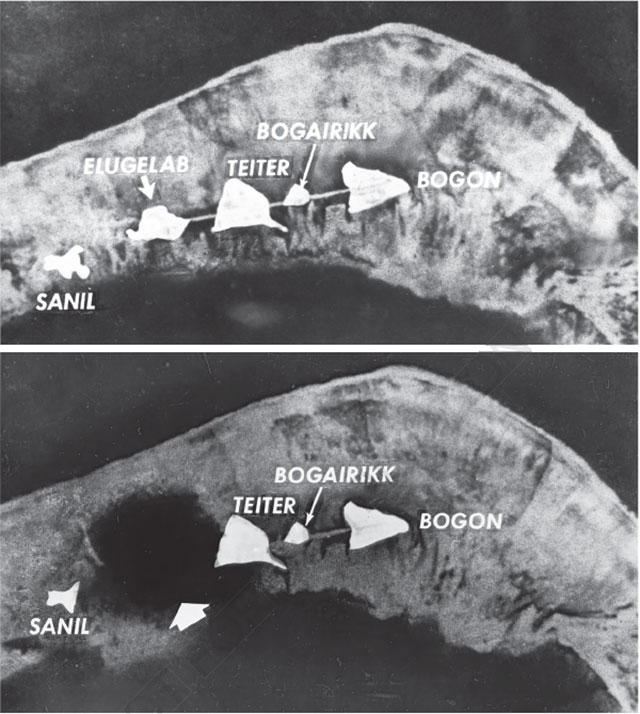
Before and after the 1952 Ivy Mike test.
National Archives
What happened after America’s war planners saw what 10.4 megatons could instantly destroy simply boggles the mind. What came next was a mad, mad rush to stockpile thermonuclear weapons, first by the hundreds and then by the thousands.
In 1952 there were 841 nuclear bombs. The next year there were 1,169.
“The process became industrialized,” historian McDuff explains. “These were not science projects anymore.”
By 1954, there were 1,703 nuclear weapons in the stockpile. The military-industrial complex was now churning out (on average) 1.5 nuclear weapons per day.
1955: 2,422. Almost two bombs per day, with 10 new systems introduced, including three new styles of thermonuclear bombs.
1956: 3,692 bombs. With production levels soaring, these mass destruction weapons were now coming off literal assembly lines at an average pace of 3.5 nuclear bombs per day.
1957: 5,543 nuclear bombs in the US stockpile—1,851 new ones in a single year. More than five per day.
And the numbers kept growing.
1958: 7,345.
And growing.
1959: 12,298.
By 1960, when the US war planners met in the underground bunker in Nebraska, the stockpile contained 18,638 nuclear bombs.
By 1967, it hit an all-time high: 31,255.
One nation. Thirty-one thousand, two hundred and fifty-five nuclear bombs.
Why stockpile 31,255 nuclear bombs when a single bomb the size of Ivy Mike, dropped on New York City or Moscow, could wipe out 10 million people? Why continue to mass-produce such weapons when the use of a single thermonuclear bomb will almost certainly ignite an unstoppable, civilization-ending nuclear war?
As the nuclear stockpile multiplied out of control, so did each of the US military branches’ plans for nuclear war. As crazy as this now seems, before December 1960, each Army, Navy, and Air Force chief had control over his own nuclear stockpile, delivery systems, and target lists. In an attempt to rein in the potential for mayhem from these multiple, competing plans, the secretary of defense ordered them all to be integrated into a single plan, which is how the Single Integrated Operational Plan (SIOP) for General Nuclear War got its name.
In 1960, Strategic Air Command (now US Strategic Command) had 280,000 employees. To work on this new plan, 1,300 of them were corralled into a Joint Strategic Target Planning Staff, men and women whose sole job was to integrate all the individual target packages into a single deck. This amalgamated plan is what John Rubel—an avionics expert slated to serve as an assistant secretary of defense under President John F. Kennedy—and his colleagues learned about that December day in the bunker beneath Offutt Air Force Base. The secret plan that, if activated, would result in the deaths of at least 600 million people on the other side of the world.
The SIOP showed how the entire US military force would be launched at Moscow in a preemptive first strike. How defense scientists had carefully calculated that 275 million people would be killed in the first hour, and that at least 325 million more people would die from radioactive fallout over the next six or so months. Roughly half of these deaths would be in the Soviet Union’s neighboring countries—countries not at war with America, but that would be caught in the crosswinds. This included as many as 300 million Chinese.
In 1960, the world’s population was 3 billion. What this meant was that the Pentagon had paid 1,300 people to compile a plan that would kill one-fifth of the people on Earth. This number did not account for the 100 million or so Americans who would almost certainly be killed by a Russian counterattack. Nor did it account for another 100 million or so people in North and South America who would die from radioactive fallout over approximately the next six months. Or the untold numbers of people who would starve to death from the climate effects of a world set on fire.
After the briefing was concluded, a second classified plan of attack was demonstrated, one that Rubel described in his 2008 memoir as being an “attack on China given by a different speaker.” It involved similar theatrics, with ladders and pointers and plastic sheets. “Eventually [this speaker] arrived at a chart showing deaths from fallout alone.” The fatalities added up to “300 million, half the population of China,” Rubel wrote.
The following morning, Rubel participated in another meeting, smaller this time. It included himself, Secretary of Defense–designate Robert McNamara, each of the Joint Chiefs of Staff, the secretaries of the Army, Navy, and Air Force, and the commandant of the Marines.
Rubel recalled that the chairman of the Joint Chiefs, Lyman Lemnitzer, “told everyone they had done a very fine job, a very difficult job, and that they should be commended for their work.” He recalled the Army chief, George Decker, expressing similar congratulatory remarks, and remembered how the chief naval officer, Arleigh Burke, “took his customary pipe out of his jaw and repeated the same message—hard job, well done, should be commended.” The last man to speak, General Thomas White of the Air Force, “ground out a comparable stream of the platitudes favored that morning in his gravelly voice, always filled with a certain air of authority.”
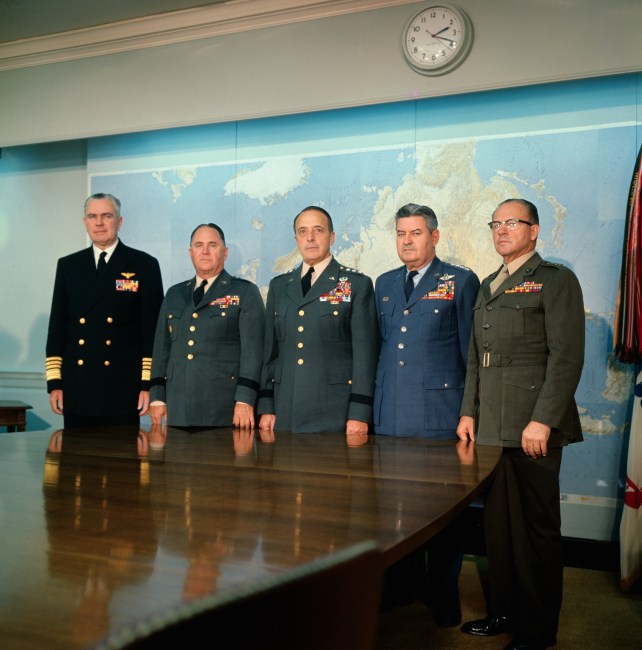
Members of the Joint Chiefs and Marine Corps Commandant Gen. David Shoup pose in a Pentagon conference room on November 13, 1961. Left to right: Adm. George Anderson (Arleigh Burke’s successor as chief of naval operations), Gen. George Decker (Army chief of staff), Gen. Lyman Lemnitzer (chairman), Gen. Curtis LeMay (Air Force chief of staff), and Gen. Shoup.
Bettmann/Getty
No one spoke up to object to the indiscriminate killing of 600 million people in a preemptive, US–led first-strike, Rubel wrote. Not any of the Joint Chiefs. Not the secretary of defense. Not John Rubel. Then, finally, one man did: Gen. David Shoup, the Marine Corps commandant, who’d been awarded the Medal of Honor for his actions in World War II.
“Shoup was a short man with rimless glasses who could have passed for a schoolteacher from a rural mid-American community,” recalled Rubel. He remembered how Shoup spoke in a calm, level voice when he offered the sole opposing view: “All I can say is, any plan that murders 300 million Chinese, when it might not even be their war, is not a good plan. That is not the American way.”
The room fell silent, Rubel wrote. “Nobody moved a muscle.”
Nobody seconded Shoup’s dissent.
No one else said anything.
According to Rubel, everyone just looked the other way.
Decades later, Rubel confessed that the SIOP had reminded him of the Nazis’ plans for genocide. In his memoir, he referred to a time when a group of Third Reich officials met at a lakeside villa in the German town of Wannsee. It was there, over the course of a 90-minute meeting, that this group of allegedly rational men decided among themselves how to move forward with the genocide in a war they were presently winning—World War II—so as to ensure total victory. Millions of people needed to die, these officials agreed.
Millions of them.
Finally, when Rubel was in his late eighties, he articulated the key similarities he perceived between that Nazi meeting and the meeting beneath Offutt Air Force Base. “I thought of the Wannsee Conference in January 1942,” he wrote, “when an assemblage of German bureaucrats swiftly agreed on a program to exterminate every last Jew they could find anywhere in Europe, using methods of mass extermination more technologically efficient than the vans filled with exhaust gases, the mass shootings, or incineration in barns and synagogues used until then.”
Nearing the end of his life, Rubel had decided to tell the world what he could not back in 1960: “I felt as if I were witnessing a comparable descent into the deep heart of darkness, a twilight underworld governed by disciplined, meticulous and energetically mindless groupthink aimed at wiping out half the people living on nearly one third of the Earth’s surface.”
The Final Solution called for the extermination of all of Europe’s millions of Jews and millions more people the Nazis considered subhuman. The plan for General Nuclear War that Rubel and his colleagues signed off on—the SIOP—called for the mass extermination of some 600 million Russians, Chinese, Poles, Czechs, Austrians, Yugoslavians, Hungarians, Romanians, Albanians, Bulgarians, Latvians, Estonians, Lithuanians, Finns, Swedes, Indians, Afghans, Japanese, and others whom US defense scientists calculated would be caught in the crosswinds.
The Final Solution was enacted. The SIOP never has been—not so far. But a similar, still-classified plan exists today. Over the years, its name has changed. It is now simply the Operational Plan (OPLAN).
When the SIOP was created, there were just two nuclear-armed nations. Today there are nine: the United States, Russia, China, France, the United Kingdom, Pakistan, India, Israel, and North Korea. Several of these countries are in direct conflict with one another. There is great instability between Pakistan and India.
Since January 2022, North Korea has test-launched more than 100 missiles, including nuclear-capable weapons that can hit the continental United States. Iran may soon have a nuclear bomb. Historians have documented at least six terrifying, nuclear close calls—each one based on early-warning data that turned out to be wrong. The possibility of a nuclear accident triggering a nuclear exchange, well chronicled by Eric Schlosser in his book Command and Control, never goes away. Nuclear command and control is a mechanized system; all systems have the capacity to fail. With the perilous introduction of AI, these threats ratchet up exponentially.
For the Nuclear Information Project, in consort with the Federation of American Scientists, project director Hans Kristensen and senior researcher Matt Korda have identified the current Operational Plan for nuclear war as OPLAN 8010-12, consisting of “‘a family of plans’ directed against four identified adversaries: Russia, China, North Korea, and Iran.” But like all the Exceptionally Controlled Information in the nuclear command and control domain, the details of what, exactly, these war plans entail are off limits to the public.
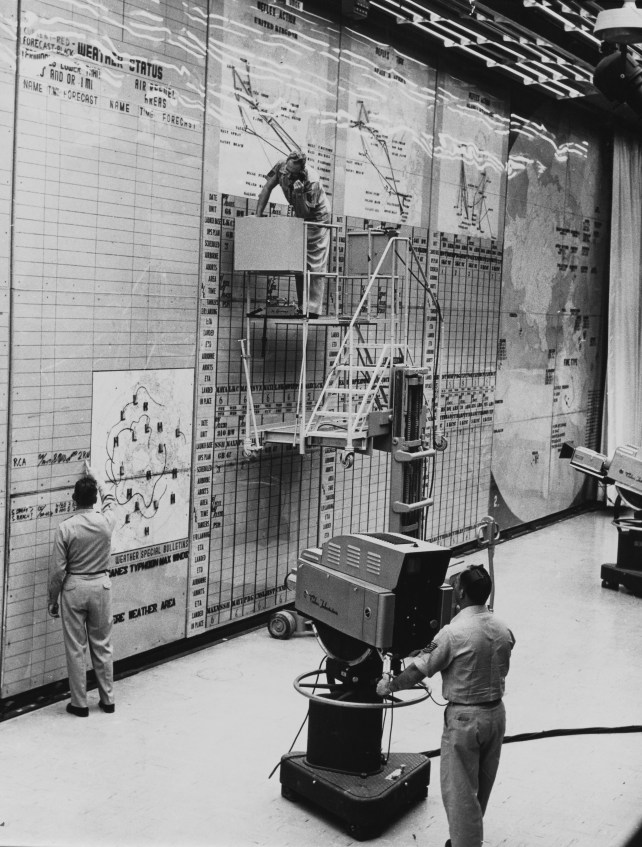
The underground command post, circa 1960, at US Strategic Air Command headquarters at Nebraska’s Offutt Air Force Base. The big board is monitored by TV cameras.
Claude Jacoby/Pix/Michael Ochs Archives/Getty
The number of nuclear weapons in the US stockpile today is smaller now than it was in 1960, but there still are 1,770 deployed weapons, a majority of which are on ready-for-launch status, with thousands more held in reserve, for a total inventory of more than 5,000 warheads. Russia has some 1,674 deployed nuclear weapons, most on ready-for-launch status, with thousands more in reserve, for a total inventory about the same size. These weapons, if used, would result in the kind of mass extermination John Rubel heard about decades ago, and that Nuclear War: A Scenario is based upon.
To insist that nuclear war is “unimaginable” is a failure of imagination. Presidents have been asking us to contemplate nuclear holocaust since the SIOP first came to be. “Today, every inhabitant of this planet must contemplate the day when this planet may no longer be habitable,” President Kennedy told the world in 1961. Four years later, President Ronald Reagan and Soviet General Secretary Mikhail Gorbachev declared in a joint statement that “a nuclear war cannot be won and must never be fought.” And President Joe Biden, in 2022, warned that “the prospect of Armageddon” is at a terrifying new high.
So here we are. Teetering at the edge—perhaps even closer than ever before.
Nuclear war is the only scenario other than an asteroid strike that could end civilization in a matter of hours. The soot from burning cities and forests will blot out the sun and cause a nuclear winter. Agriculture will fail. State-of-the-art climate modeling predicts five billion humans will die. In the words of Nikita Khrushchev, “the survivors will envy the dead.”
I wrote this book to demonstrate—in appalling, minute-by-minute detail—just how horrifying a nuclear war would be. Join the conversation. While we can all still have one.
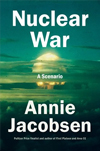
This article was adapted from Nuclear War: A Scenario, by Pulitzer Prize finalist Annie Jacobsen. If you purchase the book using this Bookshop link, a small share of the proceeds supports our journalism. Click here to read an interview with the author.
